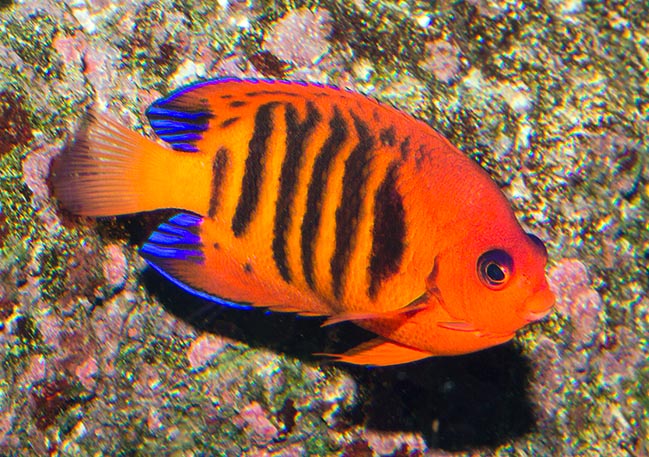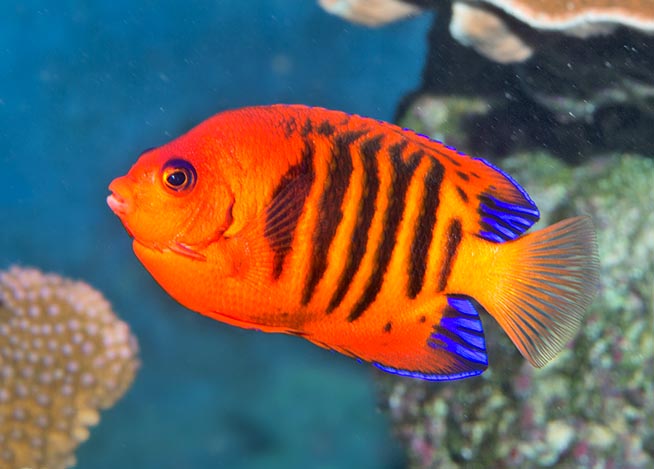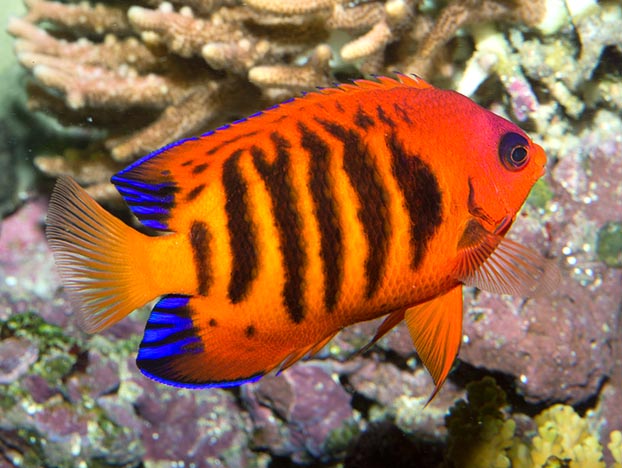Family : Pomacanthidae

Text © Giuseppe Mazza

English translation by Mario Beltramini

Centropyge loricula is frequent in aquaria due to its modest size and showy hues © Giuseppe Mazza
The showy Flame angel (Centropyge loricula Günther, 1874), belongs to the class of the Actinopterygii, the ray-finned fishes, to the order Perciformes, to the family Pomacanthidae and to the genus Centropyge which, with 32 species, is the most numerous in the family.
The etymology of the genus Centropyge comes from the Greek “kέντρον” (kentron) = sting and “πυγή” (pyg) = rearward with reference to the showy spine of the preoperculum bent towards the tail.
The name of the species loricula is the diminutive of “lorica” = breastplate, corset, with reference to the drawing with vertical bars recalling the laces of a corset.
Zoogeography
It is present in the tropical waters of the Pacific Ocean.
We find it, indicatively, in the Philippines, in Micronesia, New Guinea, Australia, New Caledonia, Vanuatu, Fiji Islands, Samoa, Tonga, Tahiti, Marquesas Islands and the Tuamotu Archipelago.

It’s the world’s most sold angelfish, with 5.000 specimens per week © Giuseppe Mazza
Ecology-Habitat
It lives among the madrepores and the corals, in the lagoons and on the cliffs of the reefs, usually between the 15 and 60 m of depth.
Morpho-physiology
In nature, it can reach the 15 cm of length, but in aquarium it rarely exceeds the 7 cm, a size which is in any case small for an angelfish, so much that in Australia they call it “Japanese pygmy angelfish”.
The body is flat, oval, with the dorsal and anal fins wide and rounded at the apex. The first counts 14 spiny rays and 16-18 soft; the second 3 spines and 17-18 unarmed rays. The pectoral fins have 17-18 soft rays, the ventral ones, spineless, are sharp and the caudal is more or less truncate. The livery is really flaming. On the yellow-orange body we note some spots and, depending on the zone, 4-6 black vertical bands, whilst the tips of the dorsal and of the anal are of an intense violaceous blue colour alternated with thin black horizontal stripes. The caudal fin, translucent at the apex, is yellow-orange. In the Marquesas Islands populations, the black vertical bands are absent. The eye, rather small and circled in black, may be mistaken as a spot at the eyes of the predators and the protruding mouth, allows it to rummage, like a small beak, among the corals.

The species is not in danger, but the habitat degradation due to fishing is often serious © Giuseppe Mazza
Ethology-Reproductive Biology
The flame angel is very shy and when it swims this is done for moving from a hiding place to another. Usually, it never goes too far from its den, and the males, slightly bigger and braver, defend a small territory, often enriched by a harem of 3-7 females.
It nourishes of seaweeds, polyps of madrepores, sponges and ascidians like its bigger relatives.
The eggs are pelagic and the young carry on a life hidden among the corals.
If fished when small, they easily adapt to the aquarium life and if well kept, they may leave even 10 years. Seen their showy colours and the modest size, every week, in the world, 5.000 of them are sold, with serious degradations for the corals, often cut at their base by the divers, just to save time, and then taken ashore in plastic bags with their valuable contents.
Luckily, the Centropyge loricula reproduces also in captivity, but to raise the young is a job for specialists. The species itself does not have any risk, due to the vast diffusion and the fact that the populations can double in less than 15 months. It has a definitely low vulnerability index: only 23 on a scale of 100.
Synonyms
Centropyge flammeus Woods & Schultz, 1953; Holacanthus loriculus Günther, 1874.
→ For general information about FISH please click here.
→ For general information about BONY FISH please click here
→ For general information about CARTILAGINOUS FISH please click here.
→ To appreciate the BIODIVERSITY of BONY FISH please click here.
→ To appreciate the BIODIVERSITY of CARTILAGINOUS FISH please click here.
